This should be easy. I’m going to sum up the 75-issue-plus-some-extra-stuff run of Neil Gaiman’s iconic Sandman comics, and do a quick spin through some of the most important characters of the first two main arcs to get us all up to speed for Netflix’s Sandman series.
EASY.
Since the long-anticipated adaptation of The Sandman is hitting Netflix on August 5th, I thought it might be fun to put together a handy list of some of the characters and references that might pop up in the show. Now to be clear I haven’t watched the show yet—I’ll be reviewing it, but only after it’s out and people have had a few days to watch. What I’m talking about below is interesting stuff from the first sixteen issues, which make up the arcs collected as Preludes and Nocturnes and The Doll’s House—those are the ones Neil Gaiman has said are being adapted in the show’s 10-episode run. Given that, it is very possible that I’m giving too much attention to literary trivia that won’t even come up in the show! But, whatever, you’ll have it for your next re-read, and it was fun to look all this stuff up.
If you want to go into The Sandman completely cold, read no further! If you’d like a refresher, come with me. And if, while you’re watching the show, you get thrown by references to 14th Century literature or 1980s DC Comics continuity, you might want to pop back into this post to look them up.
***
The Sandman hit comics racks in 1989, initially as a DC Comic before being placed under DC’s Vertigo imprint. The original series ran until 1996, resulting in 75 issues that told a complete, ridiculously well-thought-out story. Over the decades since, this run was joined on the racks by sequels and spinoffs including Death: The High Cost of Living, The Sandman: The Dream Hunters, The Sandman: Endless Nights, and The Sandman: Overture, The Dreaming, Mike Carey’s Lucifer (which itself became a TV show on Fox that was picked up by Netflix for its final seasons), Dead Boy Detectives, Sandman Mystery Theater, and a variety of one-offs and cameo appearances.
The Sandman was, especially in its early days, a horror comic, part of a line of horror comics that had sporadically risen up to be a really cool corner of the DC Universe. Its main character was Dream of the Endless, a personification of the idea of dreaming, also the person who guards the realm creatures go to when they dream, also the Guy Who Inspires Creatures to tell Each Other Stories, but also, maybe, the result of that storytelling instinct, and ultimately that instinct’s servant.
It gets complicated!
The entire point of Sandman, the big theme, the central question, is: “How do people change?” Or, sometimes: “Can people change?” And also: “How can we accept this whole ‘Death’ thing?”—“Does Desire rule our lives?”—“Is Fate real? Is there any way to circumvent it?” And sometimes: “You know what? The musical movement of the late 1970s and early 1980s that can be loosely summed up as New Wave/Goth was the fucking BEST.” And finally: “Life is story. Everything is story. We do in fact tell ourselves stories in order to live, in every possible interpretation of that statement, so best to be aware of that and keep an eye on what kind of stories you’re choosing to tell.”
The issues hop through space and time from 1300’s England to a Renaissance Festival in ‘90s Wisconsin, from Shakespeare’s London to Hell Itself, from an African city 10,000 years ago to pastoral Greece 2,500 years ago to a share house in Broward County, Florida. We open with our main character, Dream of the Endless, Morpheus, King of Dreams, Lord of the Dreaming, Prince of Stories, The Sandman Himself, imprisoned in by an occult. Things really get going seventy years later, when he escapes, takes his vengeance on his captors, begins to rebuild his crumbling kingdom, and travels from Gotham to Hell to a small-town diner to get all of his magical tools back. (Then he takes a personal day to hang out with his sister, who is Death Herself.) From there he kinda sorta battles Lucifer Morningstar, definitely battles his sibling, Desire, has a couple of whirlwind romances, tries to come to terms with his son, Orpheus (yeah, that one), deals with the curse that’s been placed on him, and, throughout all of that, muses on whether he even still wants to be Dream, and if he’s capable of changing into the anthropomorphic personification of Story Itself that mortals deserve.
Again, this is just skimming the surface, off the top of my head, what I remember from my last reread of these books from a decade ago. There’s a LOT more in there. (Also, personal nota bene: Vertigo was what really Got Me Into Comics, when I considered myself Into Them, and shaped an absurd amount of my authorial voice. I might go on a bit.)
Now I’m going to crash through some basic Sandman characters, and some characters and trivia from the first two Sandman collections: Preludes & Nocturnes and The Doll’s House.
The Endless! (In Chronological Order)
The Endless are anthropomorphic personifications of elemental forces that, in Gaiman’s telling, began with life itself, predating gods and any concept of civilization. They are, in age order:
Destiny
Destiny is the eldest Endless. He’s blind, and walks endlessly through the paths of his Garden, reading from his Book, which is also his sigil, which is chained to his wrist. Or perhaps his wrist is chained to the Book? He cannot change what he reads on the pages, and as he reads, fate comes to be. Gaiman’s Destiny is the same as the Destiny created by Marv Wolfman and Bernie Wrightson for Weird Mystery Tales.
Death
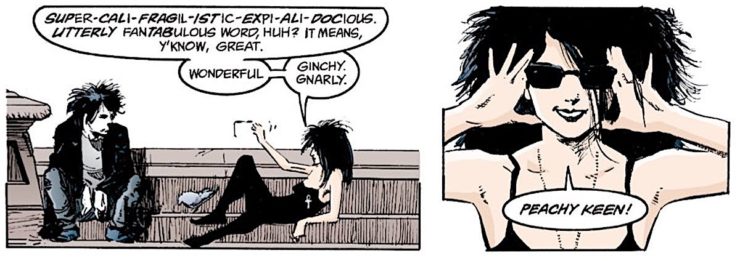
And thus a thousand perky mall Goths were born! And a thousand thousand easy-ish, last-minute Halloween costumes, including, one year, my own. Gaiman’s take on Death was a general response to the skeletal Grim Reaper-type characters, and a specific response to Terry Pratchett’s take on Death in Discworld, who speaks in small capslock and tends to be mordant and deadpan. This Death is kind, loving, funny, and usually dressed casually in black skinny jeans and a black tank top. She always wears her sigil, an ankh, in some form, and often has an eyeliner Eye of Horus looped around her right eye. She keeps pet goldfish, and once a year lives a single day as a mortal so she knows what it is to die.
In the Netflix series she’ll be played by Kirby Howell-Baptiste, who’s been amazing in Killing Eve, Barry, and The Good Place.
It would be nearly impossible for me to overstate how much this character meant to me as a kid, and still means to me now.
Dream
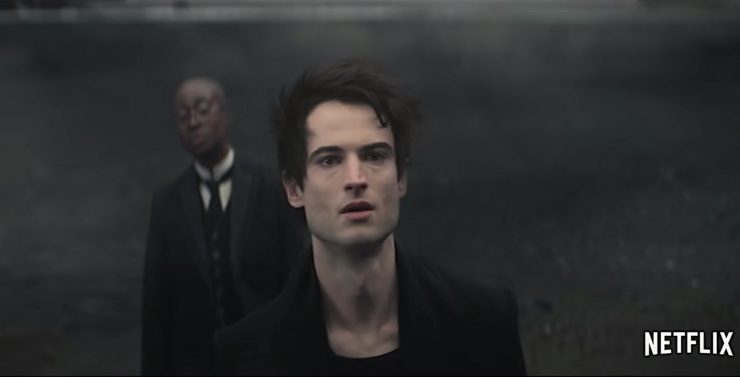
Our protagonist, though not always our hero. His realm is the Dreaming, a vast kingdom that he creates, renovates, uncreates, and protects from all comers. He tends to live in a gothic-looking castle, and eons ago he concentrated bits of his soul and a lot of his power into three tools: a Helm carved from the skull of a dead god, which is also his sigil and which looks a lot like a gas mask for Reasons I’ll Get Into Below; a Ruby, also called a Dreamstone, that manipulates reality; and a Pouch of Sand that can give mortals dreams when touched or inhaled. His eyes have stars in them—literally—and he favors cloaks and long black billowy coats. If you think he maybe looks like a cross between Robert Smith and Peter Murphy, and maybe sounds like Ian Curtis, you’re not wrong.
Destruction
Or: Sir Not Appearing In This Film. Maybe we’ll talk about him later.
Desire
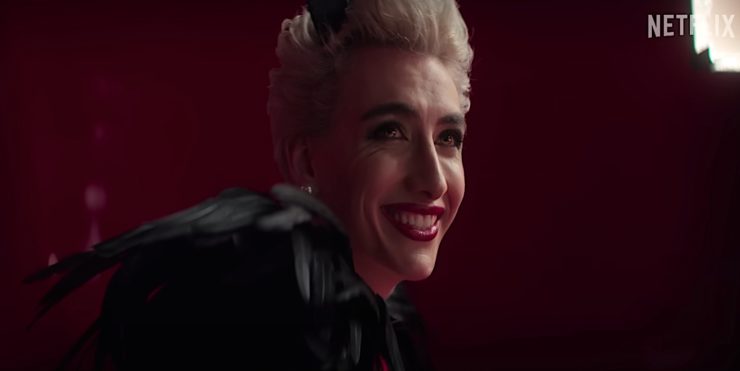
Desire is the non-binary personification of desire itself—the desire for love, sex, vengeance, beauty, fame, whatever. They were modeled off the iconic art prints of Patrick Nagel, perhaps best-known for the cover of Duran Duran’s Rio album. (Neil Gaiman got his start as an author with a biography of Duran Duran.) Desire’s realm, the Threshold, is a human body, and their sigil is, of course, a heart.
Desire will be played by the fabulous Mason Alexander Park, who was the best thing about Netflix’s Cowboy Bebop adaptation, who will be in the upcoming Quantum Leap sequel, and whom—is it okay, for me, in this professional sphere, to say I have a giant crush on this person?—whatever, I’m crushing respectfully. I’m also levitating, as an enby, to have a non-binary actor playing this role.
Despair
Desire’s twin and closest confidante. She is what she sounds like: she tends to see existence as meaningless whether she will or no, and is in terrible psychic pain most of the time. Her sigil is a fish-hooked ring, which she often wears and occasionally uses to tear her own skin. And it’s important to note: she’s the second Despair. We see the first Despair briefly in Sandman: Endless Nights.
She’ll be played by Donna Preston.
Delirium
Her mind is an ever-shifting landscape of hope, terror, joy, horror, fury, sadness, non-sequiturs, puns, sudden inspiration—sometimes she can pull herself together for a long conversation, but most of the time she is fractured and fragmented. She has one blue eye and one green, but they sometimes swap. Her realm is as kaleidoscopic as her personality, and her sigil is a nebulous swirl of color. It frustrates her that her older siblings treat her like she’s unreliable, and she does occasionally remember what it was to be Delight.
1980’s DC Continuity Hoedown, or; How Do You Fit Four Canonical Sandmen into One Comic?
The Sandman’s present-day will be the early 2020s rather than the late 1980s, so my assumption is that a lot of this continuity won’t come up! Nevertheless, I’ve listed the DC-centric stuff that turned up in The Sandman’s first two comics arcs—we might as well have this in one place in case we need it.
Arkham Asylum
The famous mental hospital of Gotham! Workplace of Dr. Harleen Qunizel and often home to The Joker, Harvey Dent, Jonathan Crane, and all sorts of other villains in Batman’s Rogues Gallery. For our purposes, it’s housing a man named John Dee at the moment.
Jonathan Crane
Otherwise known as Scarecrow, one of Batman’s coolest villains (brought to perfect-cheek-boned cinematic life by Cillian Murphy in Christopher Nolan’s Batman Trilogy) has a brief cameo in The Sandman.
John Dee
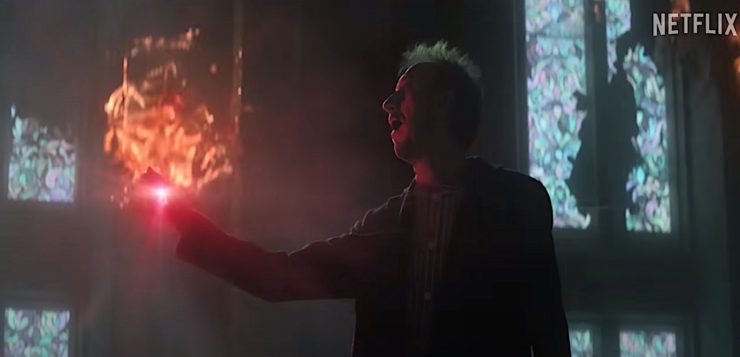
Also known as Doctor Destiny! Doctor Destiny is a long-standing DC supervillain who used a superweapon called the “Materioptikon” to manipulate reality. He captured the Garrett Sanford version of Sandman once, went up against the Justice League of America multiple times, and often ended up in Arkham Asylum—which is where he is when he enters The Sandman’s continuity. In Gaiman’s version of the character, his mother is Ethel Cripps, the former lover of Roderick Burgess, and his “Materioptikon” is actually Morpheus’ Ruby. The character was played by Jeremy Davies my beloved in the Elseworlds Arrowverse crossover, and will be played by David Thewlis, whom I also really like, in Netflix’s Sandman.
(In our continuity, John Dee was Elizabeth I’s court astrologer/science advisor. Before Elizabeth’s ascension, he tried to convince Queen Mary to found a national library [she refused] and later urged Elizabeth to take the colonization of the New World seriously. [He was seemingly the first person to use the phrase “British Empire,” which, thanks, man, that’s worked out great.] He was dedicated to the study of the occult, and believed that if he could just communicate with angels well enough they’d help him heal the rift between Catholicism and Protestantism. Still waiting on that one.)
Wesley Dodds
The OG DC Sandman, who wore a suit that was just a normal suit, but green, and a gas mask that’s the clear inspiration for Sandman’s Helm. He used “sleeping gas” to knock criminals out in Adventure Comics in the early 1940s, and was one of the founders of the Justice Society of America. In Gaiman’s retcon, Dodds fights crime as Sandman as a way to stop the terrible dreams he had while Morpheus was imprisoned, which is seemingly the Universe’s way of trying to patch Its Morpheus-shaped hole.
Garrett Sanford
A psych professor who became the 1970s take on Sandman, having been reconfigured by Joe Simon and Jack Kirby. This Sandman was trapped in the “Dream Dimension” but spent his time trying to protect kids, especially a kid named Jed, from nightmares. He was often helped by pair of living nightmares named Brute and Glob. He was also a member of the Justice League, and fought Doctor Destiny, but he finally killed himself out of the despair of being trapped in Dreams.
Jed
The aforementioned little kid, who pops up in Gaiman’s take in a very different form, and who spends a lot of time in dreams that are patterned after Winsor McCay’s classic early comic, Little Nemo in Slumberland.
Hector Hall
Hector Hall is the son of Hawkman and Hawkgirl, two Golden Age DC heroes. While a student at UCLA, he souped-up a suit made of Nth metal, fought crime as Silver Scarab, and became a member of the superteam Infinity, Inc., along with his wife, Lyta Hall.
Lyta Hall
Lyta Hall also the hero Fury, and the daughter of Golden Age Wonder Woman and Steve Trevor. She plays a pivotal role in The Sandman’s comics run, but in the press for the Netflix series she’s described as “Rose Walker’s best friend, who is mourning her husband Hector Hall”—more on Rose Walker in a second—which might mean a very different arc for the character. Shell be played by Razane Jammal.
Justice League
The Justice League of America is a team of superheroes that first appeared in DC Comics in 1960, who’ve gone through a bunch of transformations since then. In The Sandman, they confiscated Morpheus’ Ruby during one of their battles with Doctor Destiny, and apparently put it in a storage unit in “Upstate Gotham” which makes me laugh and laugh. Morpheus has no idea what the Justice League is, or who any of these super-people are, because he’s been in a magic crystal bubble since 1916.
Scott Free
Scott Free/Mister Miracle is one of Jack Kirby’s New Gods, and an escape artist. As a child his father sent him to live on the planet Apokolips in an exchange program meant to end that planet’s war with his own, New Genesis. He was raised by “Granny Goodness,” whose child-rearing practices left much to be desired. When Scott came to Earth he joined the Justice League. Morpheus’ search for his Ruby leads him to Scott, who starts to call Batman before realizing that, since it’s 3:30am, Bats will be on the clock. Instead, he wakes J’onn up.
J’onn
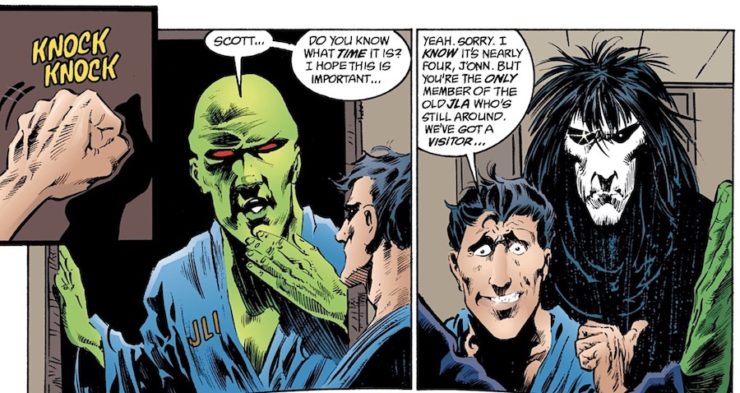
J’onn J’onzz is the Martian Manhunter, a founding member of the Justice League of America. He’s shocked to see Morpheus, kneels to him, calls him Lord L’Zoril, and later tells Scott Free that he’s a very old god.
Etrigan
Etrigan is a demon who often speaks in rhymes, which is annoying as shit. He has one half-brother who’s literally a goat, and one who’s literally Merlin—Merlin bound him to a human immortal named Jason Blood, who gets namechecked at a later point in The Sandman. Etrigan and Blood occasionally turn up in Gotham, and Etrigan also fought Swamp Thing once, rhyming all the while, and look, I’m sorry, but I can’t with this.
John/Johanna Constantine

And finally, one of my favorite characters in all of fiction! John Constantine is essentially a thought experiment: what if a working-class British punk became an occultist? He used to sing with a band called Mucous Membrane, he always wears a khaki trenchcoat, he looks like Police-era Sting (and that’s on purpose), and boy howdy has he left a lot of death and shattered lives in his wake. The character was created in 1985, for Swamp Thing’s “American Gothic” storyline. He’s appeared in his own long-lived comics series, Hellblazer, played by Matt Ryan on his own short-lived NBC show, Constantine, made appearances on CW’s Arrow and Legends of Tomorrow, and, most controversially, was transmogrified into Keanu Reeves for movie that I personally love, but that bears little relation to the original character except maybe like on a soul-level, and a slightly more DC-continuity-friendly take on the character has appeared in animated adventures including Justice League Dark: Apokolips War. (He also inspired Rupert Giles and Giles’ ne’er do well buddy, Ethan Rayne, on Buffy the Vampire Slayer, and Castiel’s style, if not personality, on Supernatural.)
For the purposes of comics!Sandman, Gaiman picks up on John Constantine’s arc ten years after his botched exorcism at Newcastle, when he tried to save a girl and instead conjured a demon who dragged her to Hell. John has also recently come back from “the Lupus Affair” in Alaska—presumably something involving former Olympian/current werewolf Anthony Lupus. Gaiman also brings Chas, John’s long-suffering BFF and occasional bandmate, into the story for a few panels. We also meet Johanna Constantine, Awesome Lady Spy and John’s ancestor, who has dealings with Morpheus during the French Revolution.
Things seems a bit different in Netflix!Sandman. There are either two Johanna Constantines, or one very long-lived one, played by Jenna Colman. I’m assuming the modern one will play the role John plays in the comics arc. Having a Johanna rather than a John will presumably serve to set her apart from the version that Matt Ryan has played over the last eight years. My big concern is that this version of Constantine is wearing a coat that seems considerably more posh than the character’s Columbo-esque number. Constantine has gone through these changes before, as Abe Reisman outlined in her long piece on the character for Vulture—in his earliest iterations he was a furious anti-Thatcherite punk who you really shouldn’t be friends with, whereas in later iterations he’s a bit more like a snarky, scruffy geezer who does magic in mainstream, full-continuity DC titles. In the Netflix Geeked event, Allan Heinberg talked about the shift by saying “the Queen and the Royal Family are clients, so you can’t really get any higher than that.”
“Or lower,” Gaiman added, and reader, I punched the air.
The Denizens of the Dreaming (Which Is ALSO DC Continuity, But Like, Weird DC)
Cain and Abel
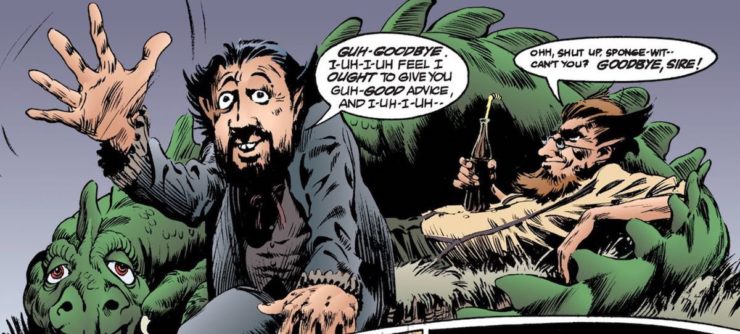
Cain and Abel are the stars of “the first story”—i.e. the moment in Genesis 4:1–18:2, when elder brother Cain is infuriated that The Lord prefers his little brother’s sacrificial offering of choice sheep to his own offering of vegetables. Rather than going after Yahweh directly, he murders Abel, then snottily asks “Am I my brother’s keeper?” when The Lord asks why ¼ of the Earth’s human population has disappeared. Just then and Abel’s blood cries out from the ground, and the Lord banishes Cain to a life of wandering, but not before putting a “mark” on his forehead so people will know not to kill him. Since suddenly there are other people, apparently.
The Cain and Abel who appear in The Sandman are the Cain and Abel who used to host a comics series… who also, after Alan Moore used them in Swamp Thing, were revealed to be the Biblical brothers. Starting in the 1950s, DC Comics ran a series called House of Mystery, with Cain as its host, and House of Secrets, with Abel as its host. In The Sandman, the two brothers live as neighbors in their respective Houses, Cain with his gargoyle, Gregory, Abel with his, named Goldie. Cain kills Abel every time he gets annoyed by him.
Eve
Eve is, again, the Biblical Eve. She lives in a cave, tending Morpheus’ ravens. She’s based on DC’s older take on Eve, who, like her sons, hosted horror comics, including Secrets of Sinister House, Weird Mystery Tales, and Secrets of Haunted House. That version of Eve kept a raven with her because it was a raven who taught her how to bury Abel after Cain killed him—which is a thing a raven actually teaches Cain to do in the Quran’s telling of the Cain and Abel story, in surah 5:27-31.
Lucien/Lucienne
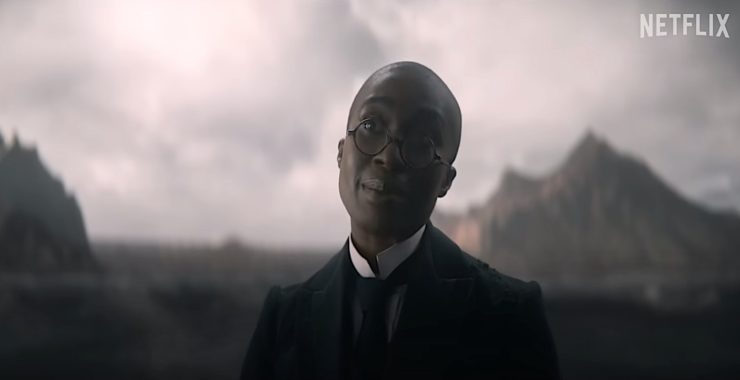
Lucien is the librarian of the Dreaming. He cares for all the books that were never finished, dreamed up and forgotten, thought about but never properly written down. In DC continuity, he hosted a very short-lived horror series called Tales of Ghost Castle, where he lived in an abandoned Transylvanian castle, guarding its library, with a werewolf.
In Netflix!Sandman, the gender-flipped Lucienne will be played by Vivienne Acheampong, and I can’t wait.
Matthew
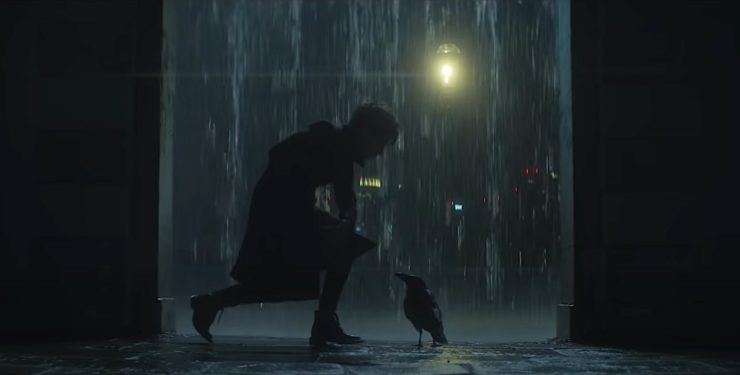
Matthew is Dream’s emotional support Raven. He’s the current incarnation of Matthew Cable, a government agent/Swamp Thing character who acted as a bodyguard to environmental scientists Alec and Linda Holland, blamed Swamp Thing for their murder, eventually came to believe that Swamp Thing was Alec Holland in a new form, and finally married Swamp Thing’s friend, Abigail Arcane. …except then he drank too much, which didn’t help their relationship, created sex golems, which really didn’t help their relationship, and, while dying in a drunken car wreck, made a deal with a fly that turned out to be harboring the soul of Abby’s abusive father, Anton Arcane, who had recently escaped Hell. After Anton attacked and killed Abby, Matthew regained control of himself just enough to send Anton back to Hell and bring Abby’s body back to life—but then he went into a coma, leaving Swamp Thing to finish the job of rescuing Abby’s soul from Hell (which of course Swamp Things does, and the two later realize they’re in love, and rather than having sex, Swamp Thing grows tubers out of his body, and Abby eats so they can feel close to each other). Then Matthew decides to become a Raven while he’s in The Dreaming, and comes out of the coma just long enough to kill himself by wrecking the machinery that’s keeping him alive.
And THAT’S why if Alan Moore wants to write a comic you get the hell out of his way.
He’ll be voiced by Patton Oswalt in the Netflix series.
The Corinthian
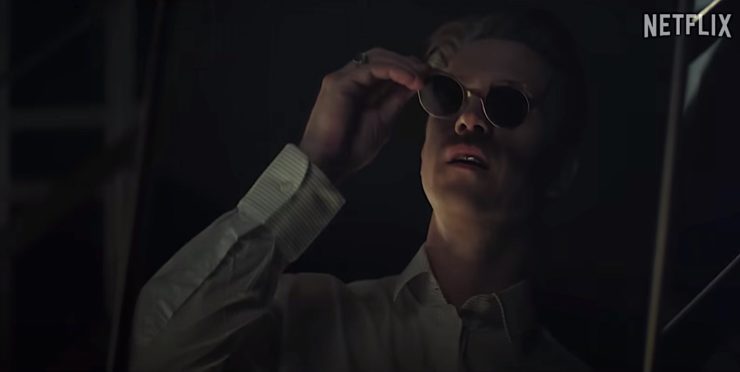
A nightmare Dream created a while ago, who broke out of the Dreaming about forty years before we catch up with him in the “Doll’s House” arc. It’s implied that he’s inspired a lot of serial killers. He has mouths where his eyes should be.
Fiddler’s Green
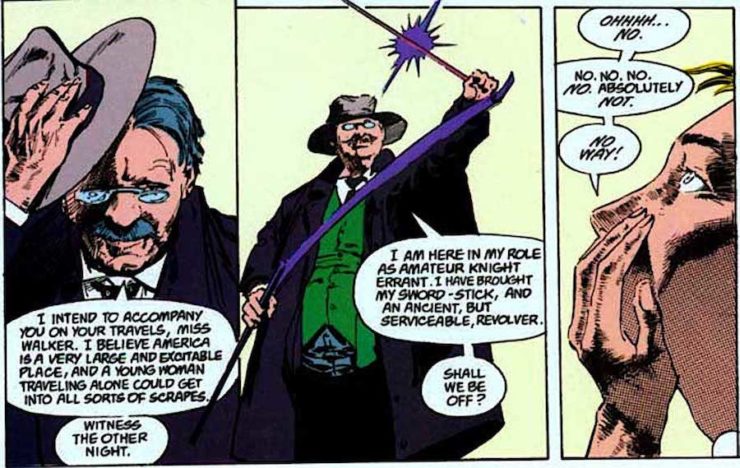
A beautiful place, when he’s part of the Dreaming. Outside of the Dreaming, he decides to take on the appearance, first name, and a bit of the personality of Gilbert Keith Chesterton (long cited by Gaiman as one of his biggest literary influences) and help a young woman named Rose Walker who’s hopelessly entangled in Morpheus’ narrative.
G.K. Chesterton was a writer, illustrator, lay theologian, and beloved public wit. His best-known fiction would be the Father Brown mysteries, about a Catholic priest who solves crime, and The Napoleon of Notting Hill and The Man Who Was Thursday, which were both speculative fiction, the first of which was an influence on Gaiman’s Neverwhere, and the second of which is one of the foundational texts of modern surrealism. His book of Christian apologetics, The Everlasting Man, was one of the books that nudged C.S. Lewis toward his eventual conversion.
Chesterton was wrong about Oscar Wilde, though, which is HILARIOUS because Gilbert/Fiddler’s Green is going to be played by Stephen Fry, who played Oscar Wilde in Brian Gilbert’s 1997 biopic Wilde.
Merv Pumpkinhead
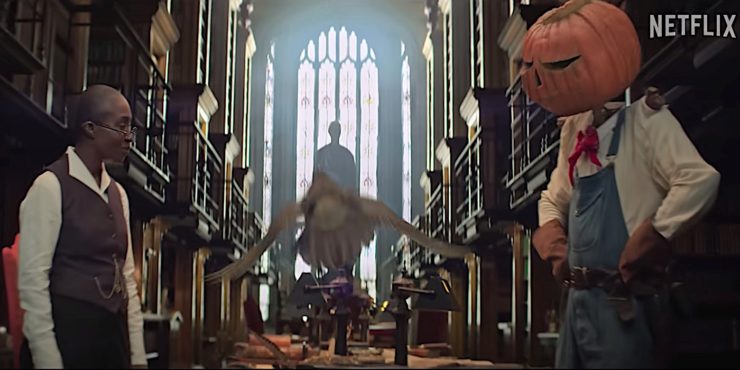
Merv Pumpkinhead (he’s the chap on the right) is essentially the superintendent of the Dreaming. As such, he gets kinda pissed when Lord Morpheus’ moods darken and take the weather down with them, or when the Boss’ drama-heavy lifestyle results in a mess he has to clean up. He’s hilarious, and, as Gaiman pointed out during a Netflix event for the show, he’s often the voice of sanity.
And he’s gonna be voiced by MARK FUCKING HAMILL.
Literary/Historical Cameos, or; The Comical Tale of How Neil Gaiman Said: “Comics Continuity? Try ‘All-Of-Literary-History-Continuity,’ Bitch!”
One of the fun things about Sandman (maybe the most fun, if you’re the right kind of nerd) is the way Gaiman consciously places his story in literary history. Writing in the late 1980s, when comics were still considered “kids’ stuff,” MAUS wasn’t in the canon yet, and only a handful of people understood that Alan Moore was one of the greatest literary geniuses of the 20th Century, Gaiman took a monthly comic book and created character who was “The Prince of Stories” who used to date a muse, who knew William Shakespeare when he was young and struggling, who could riff on Milton and Dante and Chaucer and Chesterton because he inspired all of them. Because of this, The Sandman features a wild variety of literary references. And because the story takes place over centuries, we pop in on a lot of historical events. I’ll try to sum up some of the biggest ones below for easy reference.
The Kindly Ones!

Or the Three Sisters, The Weird Sisters, The Hecatae, The Furies, The Fates—call them what you will, but try not to call them at all. They are maiden, mother, crone, they are an older take on that whole Three-In-One idea, they don’t really do mercy, and they’re weaving Morpheus’ fate whether he wants to think about it or not. Gaiman drives the point home by rolodexing through an array of names (Atropos, Tisiphone, Alecto, Magaera, Diane, Mary, Florence, Cynthia, Mildred, Mordred) which is a fun touch.
“Aleister”
In the opening issue of The Sandman, would-be magus Roderick Burgess complains about a man named Aleister mocking him. This, of course, is Aleister Crowely, the Great Beast Himself. Burgess’ cult, The Order of Ancient Mysteries, and personal drama, involving Ethel Cripps, strongly resemble Aleister’s. Burgess will be played by Charles Dance, and I am just slightly excited to see his interpretation.
Ball and Tyler
In the mini-arc “Men of Good Fortune,” one of the tavern customers references “Ball and Tyler”—“Ball” is John Ball, a priest who was part of the Peasants’ Revolt of 1381, and Tyler is Wat Tyler, one of the Revolt’s leaders. The immediate cause of the Revolt was a crushing poll tax, but the larger goal was the end of serfdom in England.
Ball (who seems to have actually read the New Testament, silly thing) pointed out that the Peasants had points to make, and gave an outdoor sermon saying:
When Adam delved and Eve span, Who was then the gentleman? From the beginning all men by nature were created alike, and our bondage or servitude came in by the unjust oppression of naughty men. For if God would have had any bondmen from the beginning, He would have appointed who should be bond, and who free. And therefore I exhort you to consider that now the time is come, appointed to us by God, in which ye may (if ye will) cast off the yoke of bondage, and recover liberty.
He was promptly hanged and drawn and quartered in front of Richard II, and his head was stuck on a pike at London Bridge.
Wat Tyler lead the Revolt into London, and even met with Richard II, who seemingly agreed to many of the groups demands before Tyler allegedly behaved rudely, Richard’s men attacked him and he was finally decapitated—his head joined Ball’s at London Bridge. Richard rescinded his agreement to the Revolt’s demands, and many other leaders were hunted down and executed. This all happen in 1381, seven years before the events of “Men of Good Fortune.”
Ball and Tyler have popped up in literature a few times, including in a short story by William Morris, T.H. White’s The Once and Future King, and Mark Twain’s A Connecticut Yankee in King Arthur’s Court. In Hamlet, Shakespeare riffed on Ball’s famous sermon:
First Clown: … Come, my spade. There is no ancient gentleman but gardeners, ditchers, and grave-makers: they hold up Adam’s profession.
Second Clown: Was he a gentleman?
First Clown: He was the first that ever bore arms.
Second Clown: Why, he had none.
First Clown: What, art a heathen? How dost thou understand the Scripture? The
Scripture says ‘Adam digged:’ could he dig without arms?
Two Popes
Again in “Men of Good Fortune,” a Medieval tavern-goer mentions two popes as a sign of the End Times. The two popes in question are Pope Urban VI and Pope Clement VII, who were both Pope because of the Western Schism, a fight within the Catholic Church that lasted from 1378 until 1417. (Deep breath) …actually…fuck that. I’ll sum up: For seventy years, the Papacy was in Avignon instead of Rome, which gave a lot of power to the French Crown. In 1377, Pope Gregory XI (who was not, afaik, a gargoyle) moved back to Rome and promptly died, at which point both Pope Urban VI and Pope Clement VII were elected, one being #TeamRome and the other #TeamAvignon. Then a third guy was elected pope in Pisa, and even after two of the popes quit in favor of still another pope, whom most people backed, two other guys declared themselves “antipope”—it was an mess.
tl;dr: most of the Church eventually agreed that Martin V was the Real Pope, and after he died, he was succeed by Pope Eugene IV in 1431. And there’s usually only been one Pope since then.
“Geoffrey”
“Men of Good Fortune” also features a cameo from Geoffrey Chaucer! Author of The Canterbury Tales, and really just an excellent example of the heights the English language can reach.
Piers Plowman
Cited here as an example of “what the people want”—as opposed to vulgarity of The Canterbury Tales. Piers Plowman is long, allegorical poem, probably by William Langland, about a man named Will who wants to be a good Christian, and who keeps falling in and out of dreams and visions that give him examples of a moral life. These visions often star “Piers,” who is sometimes a ploughman, sometimes Peter (Saint), and sometimes Christ. I think.
The Wandering Jew
The Wandering Jew story comes from a few sources, and is, of course, pretty fucking anti-Semitic. While the earliest seeds were in the Gospels, and seemed to be bandying about an Early Christian idea that some disciples were going to live until Jesus came back (however long that took), the shift into anti-Semitism came early, with Jews as a whole being compared to Cain, condemned to host a DC horror series walk the earth as a punishment for not converting. Over the centuries this idea seems to dovetail with stories of guards who hit Jesus while he was on trial. The version that became popular in 13th Century went like this: a Jewish craftsman (often a shoemaker, I’m assuming for full Mad Magazine-level irony) watched Jesus dragging his cross to Golgotha, and when he stopped for a moment, yelled at him to walk faster and hit him. At which point Jesus said something along the lines of “I’m going to rest now, but you’re not going to stop until the Last Day”—i.e. the man literally couldn’t stop moving until the End Times. The popularity of this story led to the Wandering Jew becoming a sort of Medieval European sasquatch, with people claiming sightings that, obviously, they could not actually verify. The name Ahasuerus got attached to the Wandering Jew a few centuries later, seemingly taken from the Book of Esther, even though Ahasuerus is, pointedly, not Jewish.
The idea of a lone person who couldn’t die also led to the concept of The Last Man—the final person alive after the human species had died out—that has cropped up in SFF stories ever since.
Billy Caxton
William Caxton was the man who brought the printing press to England. (Probably.) After living in Bruges, Belgium, where he had success as a printer and translator, he set up shop in Westminster, turning out copies of The Canterbury Tales, romances, and histories, and, in 1484, the first English translation of Aesop’s Fables.
Will Shaxberd

Well, surely you know who this fellow is. William Shakespeare was a good actor and occasionally knocked out a decent play. Neil Gaiman, still a very young writer at the time, decided to claim that his brand new comic book character was responsible for Shakespeare’s talent and eventual success.
I have been impressed with this choice for a long, long time.
Kit Marlowe
Christopher Marlowe, an extremely successful Elizabethan playwright, who might also have been a spy, an atheist, anti-Semitic, sympathetic to Jews, a Catholic, against religion as a whole, a brawling drunkard, and/or queer. He wrote Tamburlaine, The Jew of Malta, the somewhat homoerotic Hero and Leander, the very homoerotic Edward II, and his most famous play, The Tragical History of the Life and Death of Doctor Faustus. Faust’s whole deal looms large over Dream and Death’s agreement on Hob’s immortality, and even more over Dream’s bargain with Will Shakespeare, which is touched upon multiple times in the series. Marlowe died in 1593, under mysterious circumstances, while possibly under investigation for the aforementioned possible atheism.
(Unless he faked his death so he could secretly write all of Shakespeare’s stuff later.)
(Or he was actually a vampire, and only really died in Tangier in 2013.)
Hell

The Hell of The Sandman is informed largely by the Orig Trig itself, Dante’s Divine Comedy. The Wood of Suicides is a riff on Canto XIII of The Inferno, when Dante reaches the second ring of The Seventh Circle and finds that the souls of those who committed suicide have been transformed into groaning, sighing trees, who can only speak if someone breaks one of their branches off. The slam poetry battle that unfolds between Morpheus and Choronzon the demon is held in the City of Dis, which is a described as a walled city in The Inferno. Dis’ walls hold “Lower Hell,” including the Sixth, Seventh, and Eighth Circles, and the Well at the center that ends in the Ninth Circle.
In Dante’s version, Satan, who is called Dis, is a three-faced, weeping, pus-covered beast, forever chewing on Brutus, Cassius, and Judas Iscariot, but this is where Gaiman leaves Dante for Milton—his Lucifer is the beautiful and erudite Morningstar.
Lucifer Morningstar
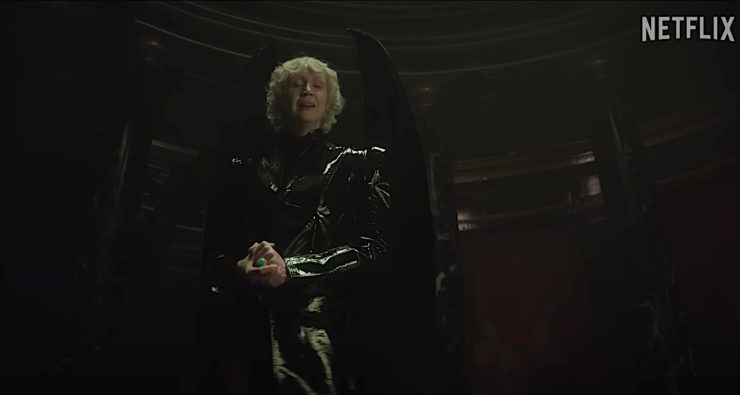
Oh hey it’s my other favorite character in all of fiction. (Or maybe my favorite underachiever in all of fact? But let’s not walk too far down that road.) Gaiman’s take on Lucifer is equally informed by John Milton and second-self-titled-album-era David Bowie. Lucifer is also one of the few being Morpheus seems to fear, at least a little.
This take on Lucifer is the one who later spun off into his own Vertigo series, Mike Carey’s Lucifer, which follows his adventures after he quits his job as Lord of Hell. That version was then adapted for the television series starring Tom Ellis, in which the character runs a nightclub and helps the LAPD solve crimes for fun, and had a cameo in the Crisis on Infinite Earths Arrowverse crossover.

However! Netflix!Sandman is going in a different direction with the character, as their Morningstar will be played by Gwendoline Christie—casting news that may have killed me and brought me back to life when I first heard it.
Beelzebub
Sometimes an alternate name for the devil, sometimes a high-level demon, sometimes “the Lord of the Flies,” possibly originally a Philistine god who was reviled by the early followers of Yahweh, definitely one of the best cameos in Queen’s “Bohemian Rhapsody.” Milton placed him in an unholy trinity of demons along with Lucifer and Astaroth, and he’s one of the antagonists in John Bunyan’s The Pilgrim’s Progress.
Azazel
A demon in some traditions, a barren place to receive the sins of the scapegoat in others, Nightcrawler’s dad in Marvel Rite Catholicism.
Choronzon
A demon associated with the OG Elizabethan John Dee and the system of Enochian, who later cropped up in Aleister Crowley’s writings, a Megadeth song, a Tangerine Dream song, and on Twin Peaks. I’m assuming Gaiman’s version is a riff on the Cenobites in Clive Barker’s Hellraiser? Cause they’re wearing a LOT of bondage gear for just a normal day in Hell.
Parliament’s War
The English Civil War, fought between the “Roundheads” of Parliament and the “Cavaliers” who supported the Royals from 1642-1651. Gaiman’s immortal character Hob Gadling fought on the Royalist side, which lost in 1651, thus putting Oliver Cromwell in charge of the British Isles. (And yes, having typed “Oliver Cromwell” I have in fact turned my head and spat on the ground, cause fuck that guy.)
Jack Hawkins
John Hawkins, a commander in the Elizabethan Navy, who, as Hob mentions, was one of the leading voices in the development of the Atlantic slave trade. Fuck that guy as well.
Mrs. Siddons
Sarah Siddons was one of the greatest actresses of the London stage, with a career that ran from the 1770s until 1819. She played numerous Shakespeare characters, including Hamlet, but was most famous for her Lady Macbeth. She would have played Cordelia in the production of King Lear that Hob mentions in “Men of Good Fortune,” and when he refers to the play having a happy ending, he’s presumably referring to a 1681 adaptation of Lear by a writer named Nahum Tate, which was enormously popular for over a century. In Tate’s version the British people rise up to defend Lear from his scheming daughters, the daughters poison each other, Cordelia marries a guy she never even talks to in the original, and Lear declares her Queen.
Margaret Thatcher
Margaret Thatcher the leader of the UK’s Conservative Party from 1975 until 1990, and served as Prime Minister from 1979 until 1990. She was pro-finance, pro-privatization, anti-union, and anti-social safety net, and pro-nationalist. John Constantine was not a fan. She supported a “Community Charge”, which resulted in a number of poll tax riots, the largest of which took place in London about three months after “Men of Good Fortune” was published.
Misc.
Plagues!
The human species has lived through a lot of these suckers. Over the course of Sandman we deal with the Black Death, a few smaller outbreaks of plague in England, Encephalitis lethargica, the 1918 flu pandemic, “Sleepy Sickness,” and, as Gaiman was writing in the late 80s and early 90s, AIDs loomed large over the series, with at least one character dying from that illness, and others referencing it. Seemingly COVID will be at least alluded to as the story is set in the early 2020s.
Cereal Convention!
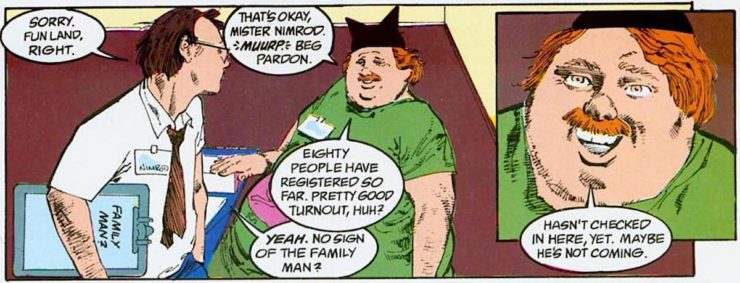
Is, of course, a serial killers convention, although they prefer to be called “Collectors.” The convention includes a variety of panels discussions (“We Are What We Are”, “Women in Serial Killing”, “There is No Sanity Clause”, the inevitable religion panel), a Guest of Honor, a disco night, and lots and lots of awkward cliques and conversations, and is probably the single greatest parody of a con I’ve ever seen. (Although I’ve been to a few con panels that were far more hostile to women than the ones shown here.) And in the end, the whole thing is brought to a screeching halt when Morpheus has more of a comment than a question.
The songs!
Over the course of “Dream a Little Dream of Me”, John Constantine hears a variety of thematically-relevant songs. These include: “Dream a Little Dream” by Doris Day; “Mister Sandman” by The Chordettes; at one point John tries to play “I Heard it Through the Grapevine” on a jukebox, and the machine inexplicably plays Patsy Cline’s “Sweet Dreams” instead; “Sweet Dreams (Are Made of This)” by the Eurythmics; “Dream Lover” by Bobby Darin; “In Dream” by Roy Orbison.
This is a cute way to show how Morpheus can manipulate reality to get mortals’ attention, and it also gets references to all these songs out of the way in one early issue.
And, Finally: Hal!
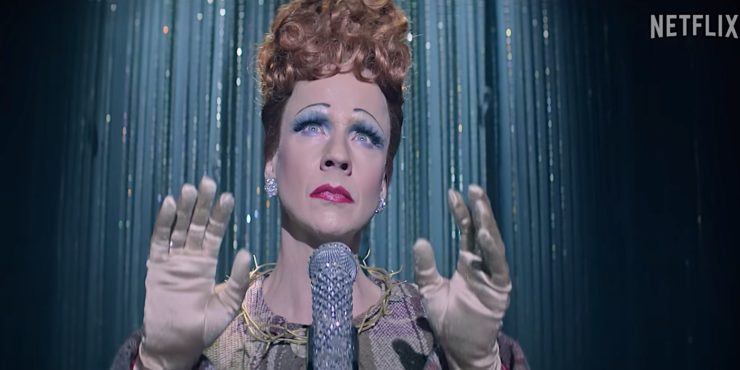
Hal turns up in The Doll’s House arc as Rose Walker’s landlord/friend. I’m not mentioning the other housemates for spoiler purposes, but I’m mentioning Hal because he’ll be played by John Cameron Mitchell, who created Hedwig and the Angry Inch, one of the Greatest Things Ever, and also Mason Alexander Park was a Hedwig, and also Mitchell directed an adaptation of Neil Gaiman’s short story How to Talk to Girls at Parties, which didn’t do as well as it should have, and which I quite liked, so I wanted to give a general shout to him and his role in the show.
***
If you’re still with me after all this, maybe you’re wondering: why did they put so much time and text into this? Why do we need to know all of this?
There are a couple of answers.
First of all, you totally don’t! If the show works anything like the comics, you can bounce right through the story and get a lot out of it even if you don’t catch any of the references or know anything about DC, or Greek myth, or English history beyond a burning hatred of Oliver Cromwell, which I assume all decent people have.
But the other answer, my answer, is that one of the things that made Sandman revolutionary was that it was part of a tradition of artwork that mixed high and low like the swirls of chocolate and vanilla in a soft-serve ice cream cone. There were lots of amazing comics before Sandman, lots of “adult” work, books that featured cool art and gorgeous storytelling, comics that were capital-I Important. But what Sandman did that, for me at least, made it really special, was it took ordinary human life and it made it mythology. It took people like Hob Gadling, a medieval soldier-for-hire, and Rose Walker, a young, depressed girl just figuring out her future, and made their stories every bit as important as the story of how Morpheus the Dream King got his magical tools back. It created a context where a gothy high school kid might look up the Peasant’s Revolt. It put the theological pyrotechnics of Chesterton on the same page with Little Nemo in Slumberland, and trusted the reader to go with it.
Which is a great artistic decision, but it’s also the underpinning of Sandman’s own importance. Because the big theme of Sandman, I think, more even than “Is Change possible?” is: Everyone is important. Everyone. No matter how annoying they are, or how much they seem like a side character, a walk-on, or a joke. Every single person has an incredible dream world in their minds. Everyone is part of this story, whether they know it or not.
Leah Schnelbach is a little more than half in love with Death, in all her guises. Come meditate on the length of a lifetime with them on Twitter!










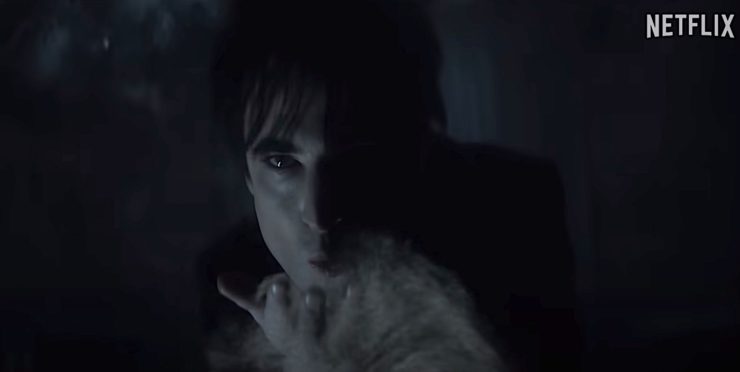
This is a wonderful write-up; thank you!
Also, this:
Destruction
Or: Sir Not Appearing In This Film.
is hilarious.
Thank you for this run down, it’s been a while since I read my Sandman, despite spending large parts of the 1990s obsessed by it, and also dressing up as Gaiman’s Death for Halloween one year.
And for Cromwell, a big fuck you from Dublin, also
and this is just the tip of the iceberg
I’m very much looking forward to this, and Gaiman’s enthusiasm for the adaptation has me very excited, and hopeful that whatever changes are made to make the adaptation work have been made thoughtfully. I think the casting is excellent. Especially Christie as Lucifer.
My only- apprehension isn’t the right word, so I’ll say curiosity- is how the changes to the first arc will work. I assumed, with the show going to Netflix, that they’d have to scale back the more obvious DC Comics characters, like J’onn, and Constantine, etc. for legal reasons. But maybe not? Maybe they got he green light? So I’m interested to see how they handle it.
4. I believe, for John at least, a major part of the switch from him to Johanna was legal-inspired – they couldn’t get the rights to John, so enter Johanna. I am curious how they’ll treat the other DC cameos, though – J’onn and Arkham Asylum being the most contentious to come to mind.
This is insane. Stellar. First rate. I am only up to vol 5 in Sandman (I’d go a lot quicker if I could just stop reading the first vols over and over again), but I cannot WAIT for the show! Neil is my Shakespeare, I’m fully convinced. What a great overview. Thanks for pulling this all together! (And some day I might actually read Dante)
This was wonderful. Looking back at the comic, it makes me realize how many references I missed. The literary and historical ones I got but the references to DC comics escaped me except for House of Mystery that I used to read in grade school.
I spent Friday/Saturday/Sunday watching the show. It didn’t take that much time but some episodes I went back and watched several times to view the ephemera in the background. I was left with real joy at seeing work successfully translated.